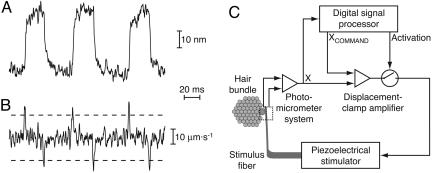Fig. 1.
Principle of the experiment. (A) The spontaneous oscillation of a hair bundle typically consists of a rapid step in the positive or negative direction, followed by a slower movement of the same polarity; thereafter, the sequence recurs in the opposite direction. (B) The temporal derivative of the foregoing trace demonstrates positive and negative spikes corresponding to the rapid movement steps. The user-defined thresholds for the detection of fast steps (dashed lines) lie well outside the range of noise. (C) In the experimental apparatus, a digital signal processor monitors the spontaneous oscillation of a hair bundle (A) and continuously computes its temporal derivative (B). When the derivative signal crosses the threshold, the processor activates the displacement-clamp amplifier and commands a specific displacement of the hair bundle (XCOMMAND). The clamp circuit then compares this command signal with the bundle's actual position (X), as measured by the photomicrometer system, and produces a feedback signal proportional to the difference. By displacing the base of the stimulus fiber, the piezoelectrical stimulator brings the fiber's tip, and the top of the hair bundle, to the commanded position.

